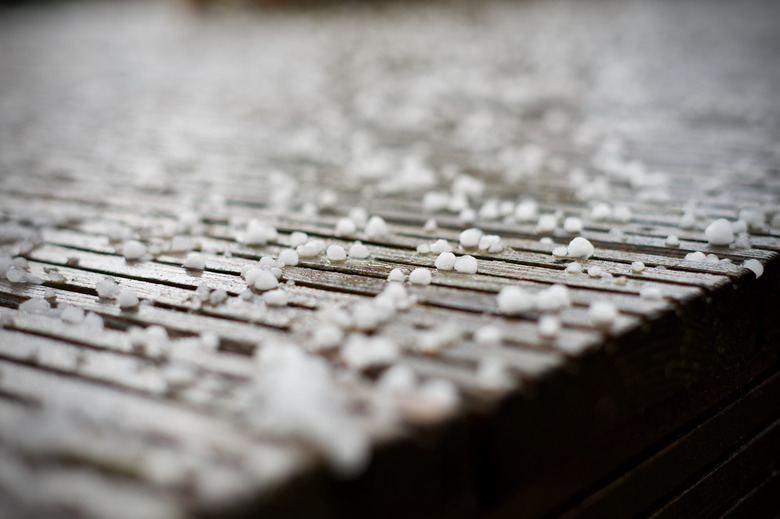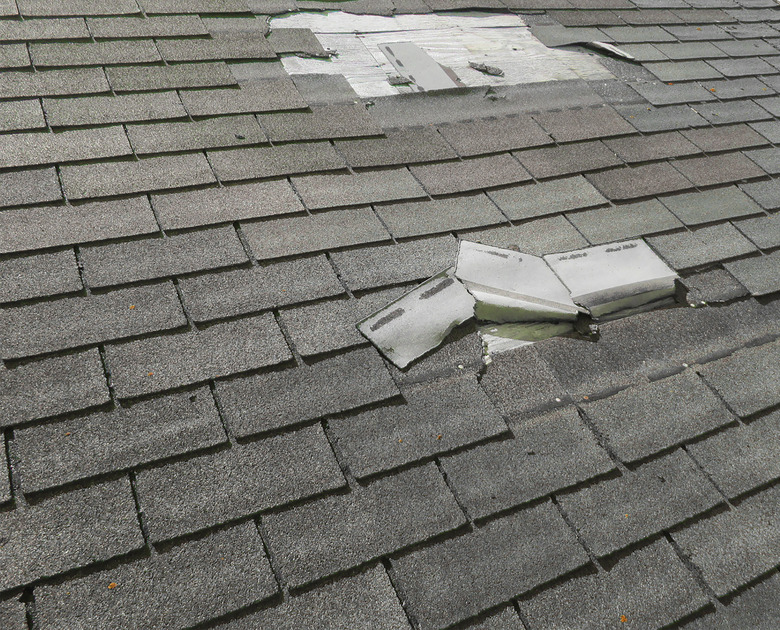What Are Impact-Resistant Shingles? Here's What You Need To Know
We may receive a commission on purchases made from links.
Impact-resistant (IR) shingles are a must-have in areas known for hail damage — like Oklahoma, Texas, and Colorado. Severe weather has a significant impact on a roof, so the better the outer roofing material resists impact, the less the potential damage from storms. Some shingles are specially designed to resist hail damage in particular — like Class 4 impact-resistant roofing shingles, which have the highest impact-resistant capability. Though they cost more up front than some other shingles, you may be eligible for a discount on homeowners' insurance premiums if you install impact-resistant shingles on your home's new roof.
Replacing your roof and interested in impact-resistant roofing? Here's everything you need to know.
Tip
Impact-resistant shingles are made to hold up better to impact from hail and debris that may hit the roof during stormy weather.
Composition of Impact-Resistant Shingles
Composition of Impact-Resistant Shingles
Impact-resistant shingles are usually made by adding polymers to the asphalt mixture during the manufacturing process. One common option is styrene-butadiene-styrene, or SBS, which rubberizes the shingle, making it both more flexible and more resistant to impact-based damage. This is often a good choice, as the rubbery quality could help keep the shingle from tearing apart over time.
Another impact-resistant shingle design simply adds a flexible polymer mesh to the back of a standard asphalt shingle. This helps keep shingles from splitting after impact from hail or debris compared to a similar shingle without the mesh backing. Not all shingles rated as impact-resistant are of the typical asphalt shingle variety. They may also be decorative styles of tile, such as synthetic versions of cedar, slate, or barrel roofing.
No matter what the composition, impact-resistant shingles retain their beneficial qualities for a while, but they may degrade over time. Eventually, they may not be quite as resistant to damage, and once they start to fail, they should be replaced just like any other shingle. The underlayment beneath the shingles should protect the roof from moisture damage, but if it's exposed to the elements for a long time, it also breaks down.
The Steel Ball Test
The Steel Ball Test
Since storm damage is a common problem in some areas of the country, it's important for professional roofers and homeowners to know which shingles are most resistant to severe weather conditions in which flying debris is a major concern. A Class 4 certification from Underwriters Laboratories (UL) indicates the shingles are able to resist impacts similar to large hail. You may be familiar with the organization from reading the labels on some of your household electrical items.
Commonly known as the steel ball test and officially called Underwriters Laboratories 2218, the UL test involves dropping 2-inch steel balls on the roofing multiple times from a height of 20 feet. If the shingle has no breaks or cracks in it afterward, it receives a Class 4 rating, which is the highest rating available. Class 4 is the roofing industry standard for impact-resistant shingles, so be sure the shingles you plan to use are Class 4 if impact resistance is a concern in your area.
Other class ratings indicate the shingle resists impact from smaller steel balls but not the 2-inch ball. For instance, Class 3 is the next highest rating, indicating resistance to impact from 1.75-inch steel balls, and Class 2 resists 1.5-inch steel ball impact. Class 1 is the lowest rating, indicating the shingles resist impact from a 1.25-inch ball. Without one of these ratings, the product probably doesn't resist impact well or hasn't been tested.
The steel ball test has nothing to do with wind resistance, so even a Class 4 shingle doesn't necessarily resist damage from high winds, which means some could still tear off during hurricane-force winds. Even though they're not windproof, Class 4 shingles will resist damage from any debris that might be carried by those high winds, which could happen with a tornado or winds strong enough to knock branches from nearby trees.
Impact-Resistant Shingles and Quality
Impact-Resistant Shingles and Quality
While a Class 4 rating is the best possible rating for impact resistance, it doesn't necessarily indicate that it's the highest-quality shingle available, much the way waterproof boots could be good for hikes through a shallow river, but the waterproof labeling doesn't necessarily mean those boots are more durable than any others. Compare the warranties on several different versions of impact-resistant shingles; generally, the longer the manufacturer's warranty, the better the quality.
Shingle manufacturers usually tout the beneficial qualities of their products on their websites, so read up on several product lines to determine what might be best given the conditions your roof faces. If you're getting quotes from several roofers for the project, also ask which IR shingles they feel are best over time and why. You'll likely get a few good opinions on quality products.
Cost Versus Long-Term Value
Cost Versus Long-Term Value
Impact resistance costs 5 to 15 percent more on average than similar shingles without the Class 4 rating. The added cost is well worth it over the years in areas prone to tornadoes, hurricanes, or hail storms. If your neighborhood experiences a hail storm, for instance, there's a good chance that any roof with impact-resistant shingles shows only minor storm damage if any compared to local homes with non-IR shingles.
Some insurance companies offer discounts for roofing with impact-resistant shingles, so it's worth your while to check with your homeowners' insurance provider for potentially specific requirements regarding the shingle type or brand that qualifies for a discount. If hiring a roofing company, make sure the company installs the particular product necessary to get an insurance discount.
In some cases, even impact-resistant shingles show dents and dings from hail if viewed from afar. Though cosmetically not as nice as they were when they were new, they should still do their job and protect the roof well compared to non-IR shingles as long as the shingles aren't cracked through. Over the years, impact-resistant shingles generally require less maintenance since they aren't as likely to break apart due to severe weather or flying debris. Standard shingles tend to be very brittle and crack or break easily, especially as they age.
When getting quotes from local roofers, ask them to itemize the expenses or better yet to offer itemized estimates for both IR and non-IR shingles. The labor fees should be the same for both types of shingles, as they're installed in much the same manner. Be leery of any roofing company that increases the installation fees simply because the shingles are more expensive than comparable non-IR shingles. Ask for an explanation if the labor fee is significantly different for IR shingles. This is why it's ultimately best to get quotes from several highly rated roofing companies rather than hiring the first one you find without any knowledge of the company's work.
References
- Owens Corning: Class 4, Impact-Resistant Roofing Shingles
- IKO Industries: What is Class 4 Impact Resistance and Why Is It Important?
- Brava: Are Class 4 Impact-Resistant Shingles Worth the Investment?
- Integrity Roofing & Painting: Impact Resistant Class 4 Shingles – Some Comparisons
- CertainTeed: Roof Toughness 101: Why You Need Class 4 Impact Resistant Shingles
- Atlas Roofing: The Highest Impact Rating Available
- First American Roofing & Siding: Hail Resistant, Class 4 Shingles: The Making Of A Durable Roof
- International Association of Certified Home Inspectors: Mastering Roof Inspections: Asphalt Composition Shingles, Part 2

